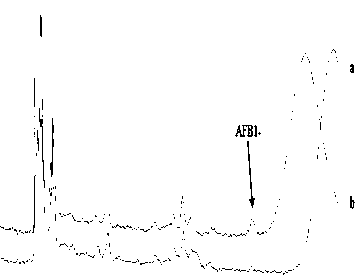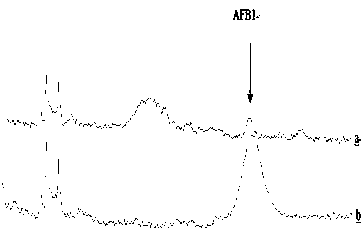Method for detecting AFB1 (aflatoxin B1) in tea
A technology for aflatoxin and tea, which is applied to measuring devices, instruments, scientific instruments, etc., can solve the problems of difficulty in widespread use, long detection time, and high detection cost, and achieves improved detection sensitivity, good purification effect, and high detection sensitivity. Effect
- Summary
- Abstract
- Description
- Claims
- Application Information
AI Technical Summary
Problems solved by technology
Method used
Image
Examples
Embodiment 1
[0029] Embodiment 1 utilizes the present invention to detect the content of aflatoxin B1 in Pu'er ripe tea
[0030] 1. Polydopamine and CTAB-coated Fe 3 o 4 Preparation of Nanomaterials
[0031] (1) Fe 3 o 4 Preparation of nanomaterials: Take 5.0 g of ferrous ammonium sulfate and 2.8 g of ferric chloride, dissolve them in 100 mL of purified water, and heat them in a water bath to 75 °C under nitrogen protection, then add 10 mL of ammonia water, continue stirring for 40 min, and finally Cool to room temperature, wash 3 times with 50 mL of pure water, and vacuum dry at 60°C for 48 hours to obtain Fe 3 o 4 nanomaterials;
[0032] (2) Polydopamine and CTAB-coated Fe 3 o 4 Preparation of nanomaterials: take the Fe prepared in step (2) 3 o 4 1 g of nanomaterials was dispersed in 30 mL of deionized water and 25 mL of 10 mM dopamine solution, the pH was adjusted to 8.5 with 0.1 M NaOH, 0.02 g of potassium persulfate was added, and stirred at room temperature for 2 h. Then add...
Embodiment 2
[0051] Embodiment 2 utilizes the present invention to detect the content of aflatoxin in black tea
[0052] 1. Polydopamine and CTAB-coated Fe 3 o 4 Preparation of Nanomaterials
[0053] (1) Fe 3 o 4 Preparation of nanomaterials: Take 4.1 g of ferrous ammonium sulfate and 4.0 g of ferric chloride, dissolve them in 100 mL of purified water, and heat them in a water bath to 85 °C under nitrogen protection, then add 10 mL of ammonia water, continue stirring for 30 min, and finally Cool to room temperature, wash 5 times with 50 mL of pure water, and vacuum dry at 70°C for 48 hours to obtain Fe 3 o 4 nanomaterials;
[0054] (2) Polydopamine and CTAB-coated Fe 3 o 4 Preparation of nanomaterials: take the Fe prepared in step (2) 3 o 4 2 g of nanomaterials were dispersed in 50 mL of deionized water and 35 mL of 10 mM dopamine solution, the pH was adjusted to 8.5 with 0.1 M NaOH, 0.05 g of potassium persulfate was added, and stirred at room temperature for 3 h. Then add 0.5 ...
PUM
 Login to View More
Login to View More Abstract
Description
Claims
Application Information
 Login to View More
Login to View More - R&D
- Intellectual Property
- Life Sciences
- Materials
- Tech Scout
- Unparalleled Data Quality
- Higher Quality Content
- 60% Fewer Hallucinations
Browse by: Latest US Patents, China's latest patents, Technical Efficacy Thesaurus, Application Domain, Technology Topic, Popular Technical Reports.
© 2025 PatSnap. All rights reserved.Legal|Privacy policy|Modern Slavery Act Transparency Statement|Sitemap|About US| Contact US: help@patsnap.com



